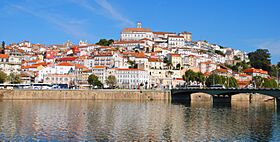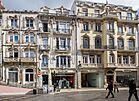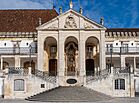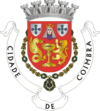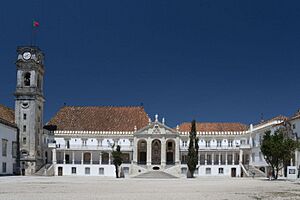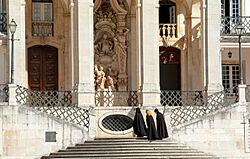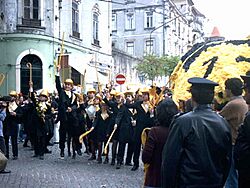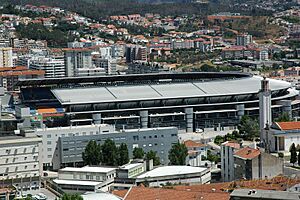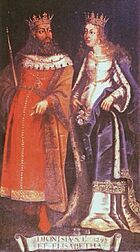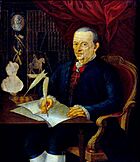Coimbra facts for kids
Quick facts for kids
Coimbra
|
|||
|---|---|---|---|
|
Municipality
|
|||
|
Clockwise: View of Coimbra from the Mondego River; University of Coimbra; Sé Nova; Coimbra waterfront; Santa Cruz Monastery; Coimbra baixa.
|
|||
|
|||
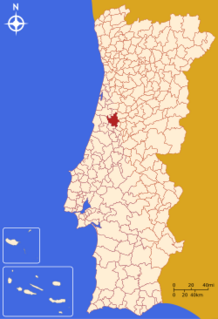 |
|||
| Country | |||
| Region | Centro | ||
| Intermunic. comm. | Região de Coimbra | ||
| District | Coimbra | ||
| Parishes | 18 (list) | ||
| Area | |||
| • Total | 319.40 km2 (123.32 sq mi) | ||
| Highest elevation | 499 m (1,637 ft) | ||
| Lowest elevation | 9 m (30 ft) | ||
| Population
(2021)
|
|||
| • Total | 140,796 | ||
| • Density | 440.814/km2 (1,141.703/sq mi) | ||
| Time zone | WET/WEST (UTC+0/+1) | ||
| Postal code |
3000
|
||
| Area code | 239 | ||
| Patron | Rainha Santa Isabel | ||
Coimbra is a lively city and a municipality in Portugal. In 2021, about 140,796 people lived here. It covers an area of 319.40 square kilometers.
Coimbra is the fourth-largest urban area in Portugal. It is bigger than most cities in the Coimbra district and the Centro Region. About 460,000 people live in the wider Coimbra area, which includes 19 municipalities.
This city has many old buildings from the Roman Empire. Back then, Coimbra was called Aeminium. You can still see parts of its old aqueduct and cryptoporticus. Coimbra was also the capital of Portugal from 1131 to 1255. Many buildings from that time are still standing.
Later, Coimbra became a major cultural center. This happened because the first Portuguese university was moved here in 1308. It is the oldest university in the Portuguese-speaking world! Many students from all over the world come to study here. Tourists also love to visit its historic buildings. In 2013, UNESCO named the university's historical buildings a World Heritage site. They said Coimbra is a great example of a university city with its own special traditions.
Contents
Exploring Coimbra's Past
Coimbra has a long and interesting history, going back thousands of years.
Ancient Roman Times
The city we know as Coimbra was once a Roman settlement called Aeminium. It was built on a hill next to the Mondego River. The Romans founded Aeminium around the time of Emperor Augustus. It was protected by a larger city nearby called Conímbriga.
Aeminium had walls and a planned layout. It even had an aqueduct, and parts of it are still visible today. When Conímbriga was attacked and abandoned, Aeminium became more important. Its location was perfect for trade, connecting major Roman cities and the coast. You can still see parts of the Roman forum's underground passages at the Machado de Castro National Museum. Later, Aeminium changed its name to Conimbriga, which then became Colimbria, and finally Coimbra.
Early Kingdoms and Legends
After the Romans, different groups like the Sueves and Visigoths came to the Iberian Peninsula. Coimbra was ruled by Hermeric, king of the Suebi. Later, Ataces, king of the Alans, took over. He rebuilt the city and called it Colimbria.
There's a legend about Coimbra's coat of arms. Ataces married Cindazunda, Hermeric's daughter. To celebrate, Ataces put his new wife's picture on a vase. On one side was a serpent, representing Hermeric, and on the other, a lion, representing Ataces. Cindazunda was shown looking up, as if thanking for peace between the two kings. This image became the symbol of Coimbra.
The Middle Ages
In 714, Muslim forces took over Coimbra. It was called Qulumriyah back then. Even though it wasn't huge, it was an important city in the northern part of Al-Andalus. You can still see parts of the old city walls, like the Almedina area, from this time.
In 1064, King Ferdinand I of León and Castile took Coimbra back for the Christians. Later, Afonso Henriques, who would become Portugal's first king, made Coimbra his home. He helped build up the city. He supported the building of the Santa Cruz Monastery in 1131 and the Old Cathedral. He also fixed the old Roman bridge.
During the Middle Ages, Coimbra was divided into two parts. The Cidade Alta (Upper City) was where important people like nobles and clergy lived. The Cidade Baixa (Lower City) was by the Mondego River, where merchants and workers lived.
A beautiful Gothic building from this time is the Monastery of Santa Clara-a-Velha. It was founded by Queen Elizabeth of Portugal in the 14th century. But it was too close to the river and often flooded. So, the nuns moved to a new monastery uphill, the Monastery of Santa Clara-a-Nova. The queen's tomb was also moved there.
Renaissance and the University
In the 15th and 16th centuries, Coimbra became an important center for art in Portugal. Many artists created beautiful works here. The Santa Cruz Monastery was updated in the Manueline style, and the tombs of Kings Afonso Henriques and Sancho I are there.
The University of Coimbra was first started in Lisbon in 1290. But in 1537, King John III of Portugal moved it permanently to Coimbra. Since then, the university has been a huge part of the city's life. The amazing Joanine Library, built in the 18th century, is one of the oldest libraries in Portugal. The tall University Tower, built between 1728 and 1733, is a famous symbol of Coimbra.
Modern Times
In 1772, the Marquis of Pombal, a prime minister, made big changes to the university. He focused more on science. Sadly, he also ordered the old medieval city walls and castle to be torn down.
The early 1800s were tough for Coimbra because of the Peninsular War with French troops. But the city recovered later in the 19th century. New things like the telegraph, gas lights, and a railway system helped it grow.
In 1911, electric trams started running, connecting the old city with new areas. More building projects happened, and the university expanded, even tearing down some old residential areas to make space.
Coimbra's Location and Nature
Coimbra is in a key location in Portugal. It's a crossroads between Braga and Lisbon. The Mondego River flows through the city, connecting inland communities with coastal towns like Figueira da Foz, which is about 40 km west. Coimbra is about 197 km from Lisbon and 116 km from Porto.
The city is surrounded by other municipalities like Penacova and Condeixa-a-Nova. Nearby, you can find beautiful mountain towns like Lousã and spa villages like Luso.
Even though Coimbra stopped being Portugal's capital in the 13th century, it's still very important. It's the main city of the Centro region. Coimbra is known for its monuments, churches, libraries, museums, parks, and lively nightlife. Its cultural life, especially around the University of Coimbra, has attracted many famous writers, artists, and academics. This is why it's sometimes called the Lusa-Atenas (Lusitanian Athens).
Natural Beauty and Green Spaces
Coimbra has many beautiful green spaces. The Botanical Garden of the University of Coimbra is one of the oldest in the world.
The city also has the Mata Nacional do Choupal and the Mata Nacional de Vale de Canas, which are national forests. Other lovely spots include Jardim da Sereia, Penedo da Saudade, Parque Manuel Braga, and Parque Verde do Mondego. The 19th-century Quinta das Lágrimas estate also has large, beautiful gardens.
There's also the Reserva Natural do Paul de Arzila, a natural reserve. It's a wetland that is home to many migratory birds and other animals and plants. The city government works to protect this area from pollution.
You can also find river beaches along the Mondego River, like Palheiros do Zorro. Coimbra is also on the Portuguese Way, a path that leads to Santiago de Compostela.
Coimbra's Weather
Coimbra has a warm-summer Mediterranean climate. In winter, temperatures are usually between 5-7°C at night and 15-16°C during the day. Sometimes it can drop below 0°C. In summer, temperatures are usually between 15-16°C at night and 28-29°C during the day. It can even reach 40°C or more on very hot days.
It rains a lot throughout the year, except in July and August. Even though Coimbra is not right on the coast, the Mondego River helps keep its winters and summers milder.
People and Communities
Coimbra is divided into 18 civil parishes, which are like small local communities.
- Almalaguês
- Antuzede e Vil de Matos
- Assafarge e Antanhol
- Brasfemes
- Ceira
- Cernache
- Coimbra (Sé Nova, Santa Cruz, Almedina e São Bartolomeu)
- Eiras e São Paulo de Frades
- São João do Campo
- São Martinho de Árvore e Lamarosa
- São Martinho do Bispo e Ribeira de Frades
- São Silvestre
- Souselas e Botão
- Santa Clara e Castelo Viegas
- Santo António dos Olivais
- Taveiro, Ameal e Arzila
- Torres do Mondego
- Trouxemil e Torre de Vilela
|
||||||||||||||||||||||||||||||||||||||||
In 2021, Coimbra had about 140,796 residents. The population has grown a little since 1991. Many people who live in Coimbra are between 25 and 64 years old. About 43,000 people come to Coimbra every day to study or work.
Most people in Coimbra live close to public services like police stations and fire stations. They also have easy access to shops, restaurants, and public transport.
Coimbra's Economy
Coimbra's economy is largely based on its University of Coimbra. The university has about 28,000 students. If you count all higher education institutions, there are over 38,000 students in the city!
Besides education, Coimbra's economy also relies on shopping, technology, and health sciences. There are many private clinics and two large state-run hospitals, including a university hospital. The national cancer hospital also has a branch here.
Many important companies are based in Coimbra. These include software companies like Critical Software and Feedzai, and pharmaceuticals companies like Bluepharma. There are also companies in engineering, ceramics, food processing, and textiles. The Instituto Pedro Nunes helps new technology companies get started.
Coimbra has a fresh produce market twice a month and a large market downtown. The Baixa (downtown) area has many cafes, bakeries, and unique shops. For bigger shopping, there are several shopping centers like Alma shopping center and Forum Coimbra.
Getting Around Coimbra
The Mondego River runs through Coimbra, and three main bridges connect its banks: the Ponte do Açude, the Ponte de Santa Clara (the oldest), and the Ponte Rainha Santa. There's also a special bridge just for walking, the Ponte Pedonal de Pedro e Inês.
The city has a good bus system called SMTUC. Coimbra also used to have a trolleybus system, which was the only one in Portugal. You can also find taxis. Coimbra is a hub for buses that travel all over Portugal and even to other countries.
Coimbra has several train stations. The main one, Coimbra-B, is on the line between Porto and Lisbon. From there, a shorter line goes to Coimbra-A in the city center. You can also travel by train to Figueira da Foz and other cities.
The A1 motorway connects Coimbra to Lisbon and Porto. There's also a small regional airport in Cernache for private flights.
On average, people in Coimbra spend about 35 minutes using public transport to get to work or school.
Learning in Coimbra
Coimbra is often called A cidade dos estudantes (The city of the students) or Lusa-Atenas (Lusitan-Athens). This is because it's home to the University of Coimbra, which is the oldest and one of the largest universities in Portugal. It has students from over 70 different countries!
The Associação Académica de Coimbra (Academic Association of Coimbra) is the oldest and biggest university students' union in Portugal, founded in 1887.
Coimbra also has other higher education schools, like the Instituto Politécnico de Coimbra (a polytechnic institute) and a nursing school. Many students choose Coimbra because of its wide range of courses, student-friendly atmosphere, and the good reputation of its schools.
The city also has many public and private schools for younger students, from kindergartens to high schools. Some of these are among the best in the country.
TUMO Coimbra
TUMO Coimbra is a special learning center for young people. It's the first one in Portugal. It helps young Portuguese people learn creative and digital skills. Over 1,000 young people are expected to attend TUMO Coimbra in its first year.
This project is supported by several companies and foundations, including Critical Software and Feedzai.
Coimbra's Buildings and Landmarks
Coimbra has many interesting buildings, both old and new.
Civic Buildings
- Forest/Moorish City of Antanhol (Portuguese: Cidade Da Mata do Antanhol), Antanhol
- Palace of Sub-Ripas (Portuguese: Paço de Sub-Ripas), Almedina
- São Sebastião Aqueduct/Garden Arches (Portuguese: Aqueducto de São Sebastião), Sé Nova
- University of Coimbra (Portuguese: Paços da Universidade de Coimbra), Sé Nova
Military Structures
- Arch and Tower of the Almedina (Portuguese: Arco e Torre da Almedina), Almedina
Religious Buildings
- Cathedral (Nova) of Coimbra (Portuguese: Sé Nova de Coimbra), Sé Nova
- Cathedral (Velha) of Coimbra (Portuguese: Sé Velha de Coimbra), Almedina
- Chapel of the Treasurer (Portuguese: Capela do Tesoureiro), Sé Nova
- Church and Convent of São Marcos (Portuguese: Igreja e Convento de São Marcos), São Silvestres
- Church of Nossa Senhora da Graça (Portuguese: Igreja da Nossa Senhora da Graça), Santa Cruz
- Church of São Domingos (Portuguese: Igreja de São Domingos), Santa Cruz
- Church of São Salvador (Portuguese: Igreja de São Salvador), Sé Nova
- Church of São Tiago (Portuguese: Igreja de São Tiago), São Bartolomeu
- College of São Agostinho (Portuguese: Misericórdia de Coimbra/Colégio de São Agostinho), Sé Nova
- College of São Jerónimo (Portuguese: Colégio de São Jerónimo), Sé Nova
- College of São Tomas (Portuguese: Portas do Colégio de São Tomas), Sé Nova
- Cross of São Marcos (Portuguese: Cruzeiro de São Marcos), São Silvestres
- Episcopal Palace of Coimbra (Portuguese: Paço Episcopal de Coimbra), Sé Nova
- Manga Cloister (Portuguese: Claustro de Manga), Santa Cruz
- Monastery of Santa Clara-a-Nova (Portuguese: Mosteiro de Santa Clara-a-Nova), Santa Clara
- Monastery of Santa Clara-a-Velha (Portuguese: Mosteiro de Santa Clara-a-Velha), Santa Clara
- Monastery of Santa Cruz (Portuguese: Mosteiro de Santa Cruz), Santa Cruz
- Monastery of Santa Maria de Celas (Portuguese: Mosteiro de Santa Maria de Celas), Santo António de Olivais
- Monastery of São João das Donas (Portuguese: Mosteiro de São João das Donas), Santa Cruz
- (Former) Church of Carmo (Portuguese: Igreja do Carmo), Santa Cruz
- (Former) Portico of the Church of Santa Ana (Portuguese: Portais da Extinta Igreja de Santa Ana), Sé Nova
- Church of Saint Bartolomew, (Igreja São Bartolomeu)
Coimbra's Culture and Fun
Coimbra celebrates its municipal holiday on July 4th. This day honors Queen Elizabeth of Portugal. There are religious and civic events, ending with fireworks.
The city has many cultural places:
- Machado de Castro National Museum: The second most important museum in Portugal.
- University of Coimbra General Library: Portugal's second biggest library.
- Botanical Garden of the University of Coimbra: An 18th-century garden.
Coimbra Fado Music
Fado de Coimbra is a special style of fado music that started in Coimbra. Famous artists like Carlos Paredes and Zeca Afonso are known for it. The Orfeon Académico de Coimbra (a famous academic choir) helps keep this music alive.
When you applaud fado in Lisbon, you clap your hands. But in Coimbra, people traditionally cough to show their appreciation!
Student Festivals
Coimbra is famous for its university student festivals. Two big ones happen every year:
- Latada or Festa das Latas ("The Tin Can Parade"): This parade happens at the start of the school year (November). It welcomes new university students, called Caloiros. Students tie tin cans to their legs to make noise. After marching, the new students are "baptized" in the Mondego River. This means they officially join the Coimbra academic family. Older students dress up the new students in funny costumes. They also carry signs with jokes about teachers or events.
- Queima das Fitas ("The Burning of the Ribbons"): This is one of the biggest student parties in Europe! It happens at the end of the school year (usually early May) and lasts for eight days. Each day is dedicated to a different faculty of the University of Coimbra. Students from other higher education schools in Coimbra are also invited to join these fun events. Many tourists come to Coimbra to see these festivals.
Music Scene
Coimbra has a lively music scene with many festivals and events. Besides the traditional Coimbra fado, there are modern bands and artists like André Sardet and The Legendary Tigerman. The Conservatório de Música de Coimbra is one of the top music schools in the country.
Media
Coimbra is an important center for media in Portugal's Centro region. The national public broadcaster, Rádio e Televisão de Portugal, has offices here. The Diário de Coimbra and Diário As Beiras are the main newspapers. The university's student union also has its own radio station, Rádio Universidade de Coimbra, and a newspaper called A Cabra.
Leisure and Fun
Coimbra offers many places to stay, from camping parks and hostels to charming hotels.
Parks and Gardens
Coimbra is full of green spaces. The Botanical Garden of the University of Coimbra is near the old university buildings. The Portugal dos Pequenitos park is a fun educational theme park. It has small-scale copies of famous Portuguese buildings.
Other green areas include the Mata Nacional do Choupal and Mata Nacional de Vale de Canas. You can also visit Jardim da Sereia, Penedo da Saudade, and Parque Verde do Mondego. The Quinta das Lágrimas estate has a large park and is now a hotel.
The Paul de Arzila is a natural reserve that protects wetlands and wildlife. You can also find river beaches along the Mondego River, like Palheiros do Zorro. Coimbra is home to the tallest measured tree in Europe, the Karri Knight, which is 72.9 meters tall!
Sister Cities
Coimbra is twinned with many cities around the world. This means they have special friendly relationships.
 Aix-en-Provence, France
Aix-en-Provence, France Beira, Mozambique
Beira, Mozambique Cambridge, United States
Cambridge, United States Curitiba, Brazil
Curitiba, Brazil Daman, India
Daman, India Dili, East Timor
Dili, East Timor Esch-sur-Alzette, Luxembourg
Esch-sur-Alzette, Luxembourg Fez, Morocco
Fez, Morocco Macau, China
Macau, China Padua, Italy
Padua, Italy Poitiers, France
Poitiers, France Salamanca, Spain
Salamanca, Spain Santa Clara, United States
Santa Clara, United States Santiago de Compostela, Spain
Santiago de Compostela, Spain Santos, Brazil
Santos, Brazil São Vicente, Cape Verde
São Vicente, Cape Verde Zaragoza, Spain
Zaragoza, Spain
Sports in Coimbra
Coimbra is home to a large sports club called Associação Académica de Coimbra (known as Académica). It's the university's student union and is involved in many sports like rugby, volleyball, handball, basketball, and football.
Académica also has a professional football team that plays in the Liga 3. They play at the Estádio Cidade de Coimbra. Another traditional sports club is the Clube de Futebol União de Coimbra.
The Estádio Cidade de Coimbra is a big stadium with 30,000 seats. It was used for the 2004 European Football Championship. It also has Olympic swimming pools. Other important sports venues include the Estádio Municipal Sérgio Conceição and the Estádio Universitário de Coimbra.
Here are some major sports teams in Coimbra:
| Team | Sport | League | Venue |
|---|---|---|---|
| Associação Académica de Coimbra | Football | Liga Portugal 2 | Estádio Cidade de Coimbra |
| Associação Académica de Coimbra - Secção de Basquetebol | Basketball | Portuguese Basketball League (LCB) | Pavilhão Multiusos de Coimbra |
| Associação Académica de Coimbra - Secção de Rugby | Rugby | Campeonato Nacional Honra/Super Bock | Estádio Universitário de Coimbra |
| Associação Académica de Coimbra - Secção de Voleibol | Volleyball | Portuguese Volleyball League A1 | Estádio Universitário de Coimbra |
| C.F. União de Coimbra | Football | Campeonato de Portugal | Estádio Sérgio Conceição |
| Agrária | Rugby | Campeonato Nacional de Rugby I Divisão | Campo da Escola Agrária |
Famous People from Coimbra
Many notable people were born, lived, or died in Coimbra:
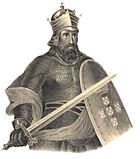
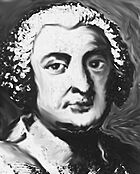
Royalty & Nobles
- Cindazunda (5th century): A princess whose image is on Coimbra's coat of arms.
- Afonso Henriques (c.1109–1185): Portugal's first king, buried in the Monastery of Santa Cruz.
- Sancho I (1154–1212): Portugal's second king.
- Afonso II (1185–1223): Portugal's third king.
- Sancho II (1209–1248): King of Portugal.
- Afonso III (1210–1279): First King of Portugal and the Algarve.
- Saint Elizabeth of Portugal (1271–1336): Queen, wife of King Denis I, buried in the Monastery of Santa Clara-a-Velha.
- Pedro I (1320–1367): King of Portugal.
- Ferdinand I (1345–1383): King of Portugal.
Public Service
- Fernando Martins de Bulhões (1195–1231): A Catholic priest, also known as Saint Anthony of Padua.
- Pedro Nunes (c.1502–1578): A famous mathematician and mapmaker.
- Mem de Sá (c.1500–1572): Third Governor-General of Brazil.
- Saint José de Anchieta (1534–1597): A Jesuit writer who studied in Coimbra.
- Joaquim António de Aguiar (1792–1884): A politician who was Prime Minister of Portugal three times.
- Sister Lúcia (1907–2005): One of the children who saw Our Lady of Fátima.
- Carlos Mota Pinto (1936–1985): A professor and former Prime Minister of Portugal.
- Pedro Passos Coelho (born 1964): A politician and former Prime Minister of Portugal.
Arts and Culture
- Francisco de Sá de Miranda (1481–1558): A Renaissance poet.
- Carlos Seixas (1704–1742): A composer and musician.
- Joaquim Machado de Castro (1731–1822): One of Portugal's most important sculptors.
- Miguel Torga (1907–1995): A famous Portuguese writer.
- Carlos Paredes (1925–2004): A brilliant guitar player.
- José Afonso (1929–1987): A Portuguese singer-songwriter, known as Zeca.
- Luís de Matos (born 1970): A Portuguese magician.
- André Sardet (born 1976): A Portuguese singer.
Sports
- Sérgio Conceição (born 1974): A famous football manager and former player.
- João Neto (born 1981): A Portuguese judo champion.
- Filipe Albuquerque (born 1985): A Portuguese racing car driver.
- Miguel Veloso (born 1986): A footballer who played for Portugal's national team.
- Diogo Ribeiro (born 2004): A Portuguese swimming world champion.
Images for kids
-
Arcos do Jardim, built between 1568 and 1570 on the remains of a Roman aqueduct
-
The Manueline façade of the Monastery of Santa Cruz, final resting place of the first Portuguese monarch (Afonso Henriques).
-
Monastery of Santa Clara-a-Velha, refounded in 1314 by Queen Elizabeth of Portugal as a convent of Poor Clares in the parish of Santa Clara
See also
 In Spanish: Coímbra para niños
In Spanish: Coímbra para niños


